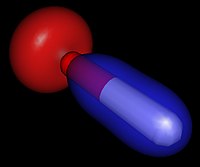
Photo from wikipedia
Abstract DFT calculations were carried out to investigate hydrogen release and diffusion behaviors. Results demonstrated that MgH2/TiH2 interface is thermodynamically stable with negative adhesion energy of −1.33 J/m2 with respect to… Click to show full abstract
Abstract DFT calculations were carried out to investigate hydrogen release and diffusion behaviors. Results demonstrated that MgH2/TiH2 interface is thermodynamically stable with negative adhesion energy of −1.33 J/m2 with respect to the individual MgH2 and TiH2 slabs. The formation of MgH2/TiH2 interface alters the interstice structure and space of the interstitial sites where H atoms located and then significantly lowers the dehydrogenation energy of hydrogen releasing from both the MgH2 and TiH2 slabs nearby the interface comparing the bulk MgH2 and TiH2. The smallest dehydrogenation energy of 0.06 eV/H could be reached when H releases from MgH2 side. The study also illustrates that the existence of the MgH2/TiH2 interface promotes the diffusion of hydrogen vacancy. The lowest diffusion barrier of hydrogen vacancy in the MgH2 slab (from the sublayer to the frontier layer to the interface) is estimated as 0.21 eV. Based on the present study, one can deduce that the dehydrogenation of the MgH2/TiH2 system will start by H releasing from MgH2 slab, which generates H vacancies near the interface, then the interior H of MgH2 migrates to the H vacancies (diffuse of H vacancies in the opposite direction) and releases. The TiH2 acts as a catalyst promoting the generation and diffusion of H vacancies in MgH2. Therefore synthesizing of MgH2/TiH2/MgH2 sandwich structure could be an effective approach to promote the dehydrogenation process of MgH2, and an ideal structure owning geometric hydrogen capacity of 6.45 wt%.
Journal Title: International Journal of Hydrogen Energy
Year Published: 2020
Link to full text (if available)
Share on Social Media: Sign Up to like & get
recommendations!